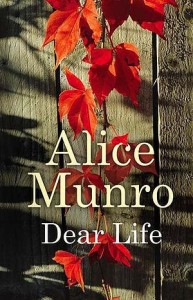I do like Munro’s short stories – here, here and here.
Here is the blurb …
Alice Munro captures the essence of life in her brilliant new collection of stories. Moments of change, chance encounters,the twist of fate that leads a person off the accustomed path and on to a new way of thinking and being: the stories in Dear Life build to form a radiant, indelible portrait of just how dangerous and strange ordinary life can be.
Many of these stories are grounded in Munro’s home territory – the small Canadian towns around Lake Huron – but there are departures too. A poet, finding herself in alien territory at her first literary party, is rescued by a seasoned Newspaper editor, and is soon hurtling across the continent, young child in tow, towards a hoped for but completely unplanned meeting. A young soldier, returning to his fiancee from the Second World War steps off the train before his stop and onto the farm of another woman beginning a life on the move.
The book ends with four powerful pieces, ‘autobiographical in feeling’, set during the time of Munro’s own childhood, in the area where she grew up. Munro describes this quartet as ‘not quite stories’ but ‘the first and last – and the closest – things I have to say about my own life’. Suffused with Munro’s clarity of vision and her unparalleled gift for storytelling, these and the other stories in Dear Life are cause for celebration.
Munro is the master of making the ordinary extraordinary. Her stories are about small lives – mostly living in rural communities – but they grapple with ‘big’ emotions: loneliness, betrayal, despair, unexpected kindness.
This book consists of 14 stories (I had read one before Amundsen) and the cover a range of themes – love, aging, adultery, society expectations. Munro’s prose is simple, but compelling I didn’t want any of the stories to finish – particularly Corrie (how could everything continue as before after such a betrayal). Munro highlights what most people (the majority of people) will and do put up with in their lives. These aren’t grand sweeping epics, but finely detailed miniatures.
I especially enjoyed the references to L M Montgomery’s work – there is this in The Eye…
And in my interpretation of the picture that hung at the foot of my bed, showing Jesus suffering the little children to come unto him. Suffering meant something different in those days, but that was not what we concentrated on. My mother pointed out the little girl half hiding round a corner because she wanted to come to Jesus but was too shy.
Reminds me of this in Anne of Green Gables …
“That,” she said, pointing to the picture—a rather vivid chromo entitled, “Christ Blessing Little Children”—”and I was just imagining I was one of them—that I was the little girl in the blue dress, standing off by herself in the corner as if she didn’t belong to anybody, like me. She looks lonely and sad, don’t you think? I guess she hadn’t any father or mother of her own. But she wanted to be blessed, too, so she just crept shyly up on the outside of the crowd, hoping nobody would notice her—except Him. I’m sure I know just how she felt. Her heart must have beat and her hands must have got cold, like mine did when I asked you if I could stay. She was afraid He mightn’t notice her. But it’s likely He did, don’t you think? I’ve been trying to imagine it all out—her edging a little nearer all the time until she was quite close to Him; and then He would look at her and put His hand on her hair and oh, such a thrill of joy as would run over her! But I wish the artist hadn’t painted Him so sorrowful looking. All His pictures are like that, if you’ve noticed. But I don’t believe He could really have looked so sad or the children would have been afraid of Him.”
And there was references to Anne of Green Gables and Pat of Silver Bush in Dear Life and how Anne must have ignored the manure as she did.
More reviews …
http://cgblake.wordpress.com/2013/05/20/book-review-dear-life-by-alice-munro/
http://www.guardian.co.uk/books/2012/nov/25/dear-life-alice-munro-review
…

